This article was written by guest-author Shane Hanofee is a Botany Technician and Chapter President of Redbud Chapter of the California Native Plant Society based in Grass Valley, CA.
Part 2 – More Sierra Nevada Fungi Finds
What’s Poppin in the Sierras – Fall 2021
Warning: Mushrooms can be toxic when consumed! This is not a guide to edible mushrooms although some mushrooms are edible.
Shaggy Mane
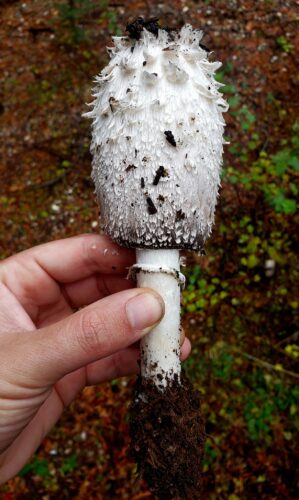

 The shaggy mane. Perhaps the most charismatic of the ink caps. Coprinus comatus. But like much beauty, it’s charm is fleeting as it will deliquesce into a gooey-black spore-filled liquid in only a few days. I once tried to make ink from the drippings. I had a real hard time getting the consistency right but I suppose it could work if you don’t mind your ink smelling like putridity. I did try adding peppermint oil to mask the smell but it really just ended up smelling like a candy cane dipped in raw sewage.
The shaggy mane. Perhaps the most charismatic of the ink caps. Coprinus comatus. But like much beauty, it’s charm is fleeting as it will deliquesce into a gooey-black spore-filled liquid in only a few days. I once tried to make ink from the drippings. I had a real hard time getting the consistency right but I suppose it could work if you don’t mind your ink smelling like putridity. I did try adding peppermint oil to mask the smell but it really just ended up smelling like a candy cane dipped in raw sewage.
Phaeocollybia olivacea
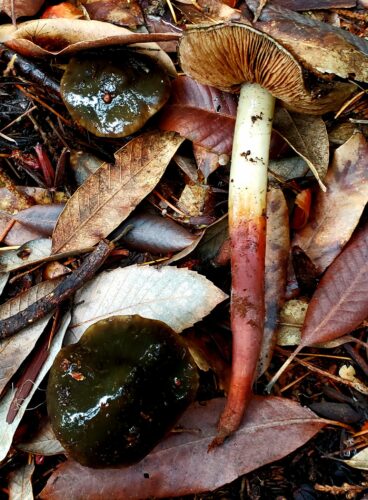

 Phaeocollybia olivacea with its eye-catching display of stark colorsand interesting textures. The long rooting stipe with reddish colors at the base, deep olive-green cap, brownish gills producing brownish spores. Don’t let the tanoak leaves fool you, it is instead associated with the intermixed conifers whose litter can be seen beneath the broadleaves. That rooting stipe breaks somewhat easily, as I discovered the hard way, and the coloration at the base can be instructive so dig it out carefully. But a break is at least an opportunity to see that the stipe is pithy inside. A lookalike has a hollow stipe.
Phaeocollybia olivacea with its eye-catching display of stark colorsand interesting textures. The long rooting stipe with reddish colors at the base, deep olive-green cap, brownish gills producing brownish spores. Don’t let the tanoak leaves fool you, it is instead associated with the intermixed conifers whose litter can be seen beneath the broadleaves. That rooting stipe breaks somewhat easily, as I discovered the hard way, and the coloration at the base can be instructive so dig it out carefully. But a break is at least an opportunity to see that the stipe is pithy inside. A lookalike has a hollow stipe.
Leucopaxillus Gentianeus
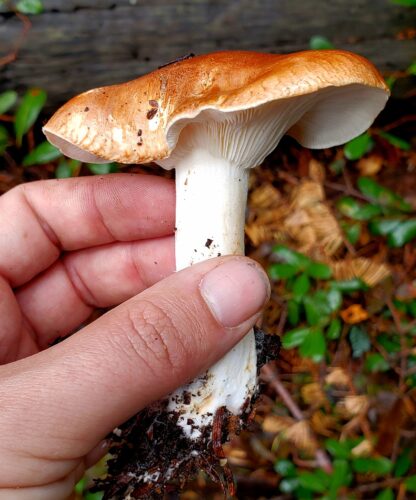


Leucopaxillus gentianeus. With its size and white colors everywhere except for the well-done pancake cap, it should be easy to recognize. But in case you have any doubt, take a little nibble. It will be strongly bitter and unpleasant!
Pleurotus Pulmonarius
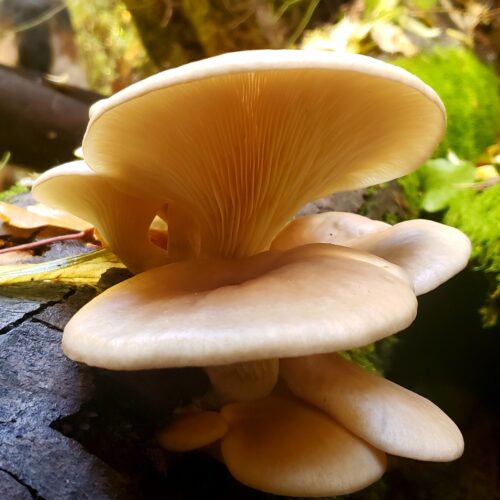

 Ah, the pearl of the forest. Pleurotus pulmonarius here fruiting from alder wood that had fallen across a small creek. I had to be informed this was pulmonarius and was pointed to the warmer colors than the bluish-grays of P. ostreatus. But I suspect more work needs to be done with the complex and things could move around so for now, I’m just rolling with the expert input I recieved.
Ah, the pearl of the forest. Pleurotus pulmonarius here fruiting from alder wood that had fallen across a small creek. I had to be informed this was pulmonarius and was pointed to the warmer colors than the bluish-grays of P. ostreatus. But I suspect more work needs to be done with the complex and things could move around so for now, I’m just rolling with the expert input I recieved.
Pleurotus Dryinus
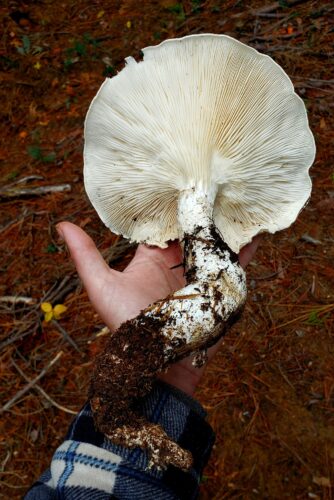

 Sometimes you pull a mushroom out from the base of a rotting tree and it just keeps coming and coming. Like this here Pleurotus dryinus and it’s intensely long stipe. Same genus as the one above but this one has a veil when young. Some small remnants on the stipe are evident of that.
Sometimes you pull a mushroom out from the base of a rotting tree and it just keeps coming and coming. Like this here Pleurotus dryinus and it’s intensely long stipe. Same genus as the one above but this one has a veil when young. Some small remnants on the stipe are evident of that.
Panellus mitis
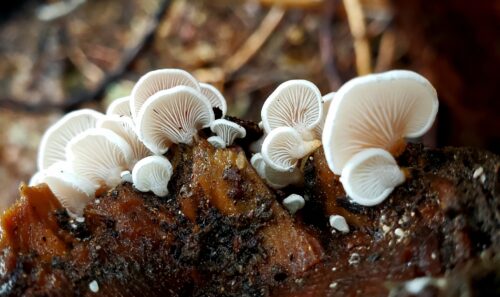


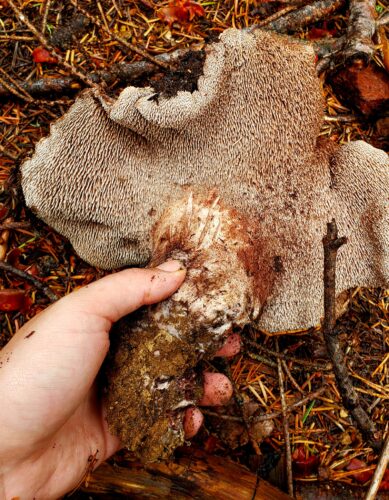

 This behemoth has teeth! This is a Sarcodon sp, I think S. rimosus due to the blackish KOH reaction that I got from the cap and its mealy odor. In any case, the scaly cap and toothed underside are distinctive to the genus.
This behemoth has teeth! This is a Sarcodon sp, I think S. rimosus due to the blackish KOH reaction that I got from the cap and its mealy odor. In any case, the scaly cap and toothed underside are distinctive to the genus.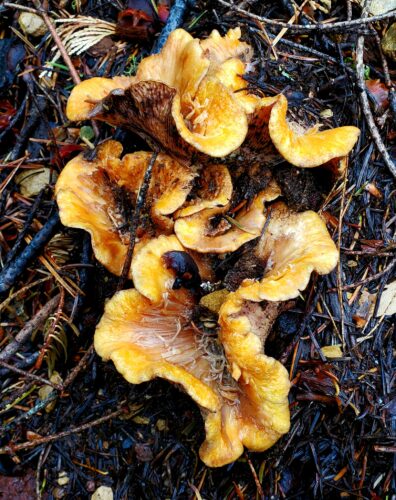

 Another large, scaly capped friend growing nearby is this one. That fluted shape and orange colors flutters the heart that chantrelles have just been found. But already I know from the cap scales that this is instead Turbinellus floccosus.
Another large, scaly capped friend growing nearby is this one. That fluted shape and orange colors flutters the heart that chantrelles have just been found. But already I know from the cap scales that this is instead Turbinellus floccosus.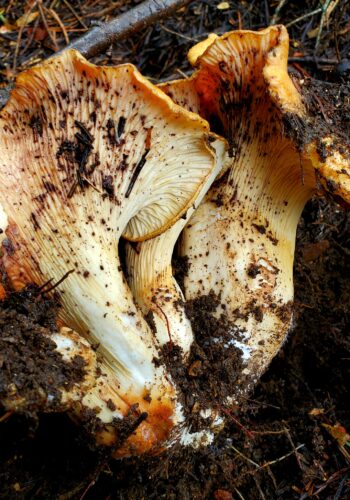


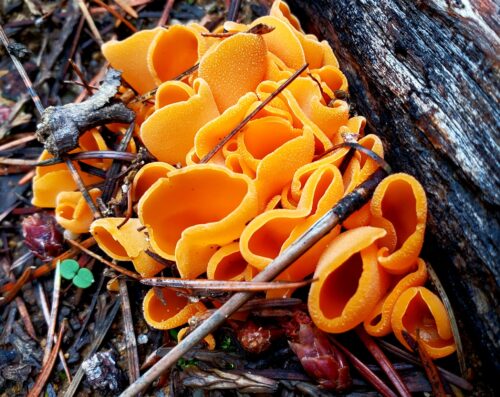

 The reason why I hate hikers who toss their orange peels on the trailsides. I’m going to go over to it thinking it may be this species, Aleuria aurantia. It likes disturbed areas like this logging road and it lacks a stipe which would indicate a different species. I do much enjoy its bright colors standing out amongst the subdued hues of the ground.
The reason why I hate hikers who toss their orange peels on the trailsides. I’m going to go over to it thinking it may be this species, Aleuria aurantia. It likes disturbed areas like this logging road and it lacks a stipe which would indicate a different species. I do much enjoy its bright colors standing out amongst the subdued hues of the ground.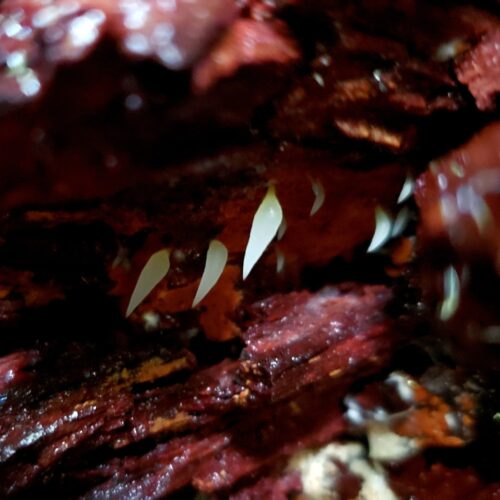

 Mucronella fusiformis is a fungal icicle drooping down from downed logs. They occur kind of scattered and that narrowed point of attachment is what I’m looking for when trying to discern this species from others. The yellow species is also quite nice to find. Nothing quite hinders the progression of a mushroom hike like a well-rotted downed tree.
Mucronella fusiformis is a fungal icicle drooping down from downed logs. They occur kind of scattered and that narrowed point of attachment is what I’m looking for when trying to discern this species from others. The yellow species is also quite nice to find. Nothing quite hinders the progression of a mushroom hike like a well-rotted downed tree.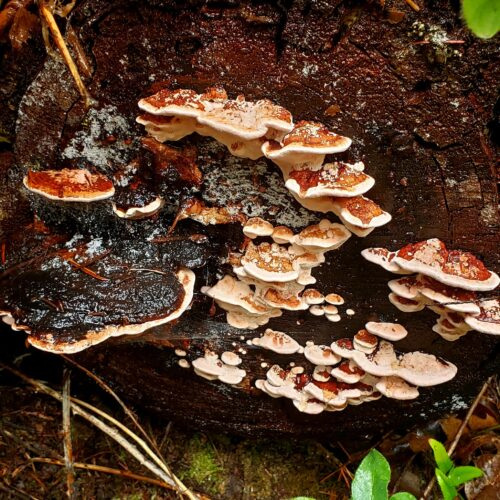

 One of my favorite polypores for its White Stripes inspired coloration. Black, red, and white. The pore surface has a pinkish cast which deepens in color slightly when scratched. This is Rhodofomes cajanderi though the genus name has quotation marks in MotRC which are not explained in the comments. Perhaps this goes by a different name now or will do so in the future. Has any work been done on these that you, dear reader, are aware of? Drop knowledge on the comments.
One of my favorite polypores for its White Stripes inspired coloration. Black, red, and white. The pore surface has a pinkish cast which deepens in color slightly when scratched. This is Rhodofomes cajanderi though the genus name has quotation marks in MotRC which are not explained in the comments. Perhaps this goes by a different name now or will do so in the future. Has any work been done on these that you, dear reader, are aware of? Drop knowledge on the comments.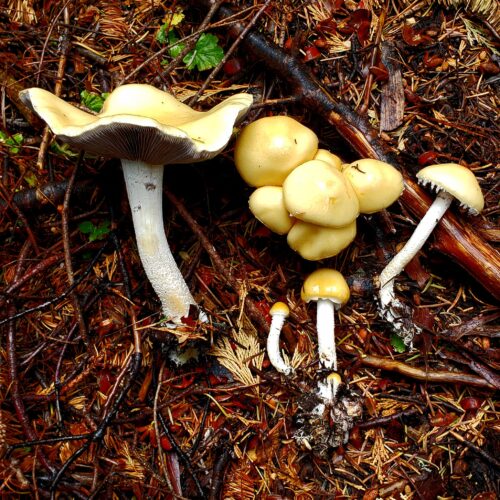

 We close with a common but never not welcomed sight which often occurs in large photogenic numbers. The large size, yellow cap with tattered veil remnants, white stipe, and dark gills can only point to Stropharia ambigua. This is an easy roadside ID, recognizable even at 70 mph.
We close with a common but never not welcomed sight which often occurs in large photogenic numbers. The large size, yellow cap with tattered veil remnants, white stipe, and dark gills can only point to Stropharia ambigua. This is an easy roadside ID, recognizable even at 70 mph.



